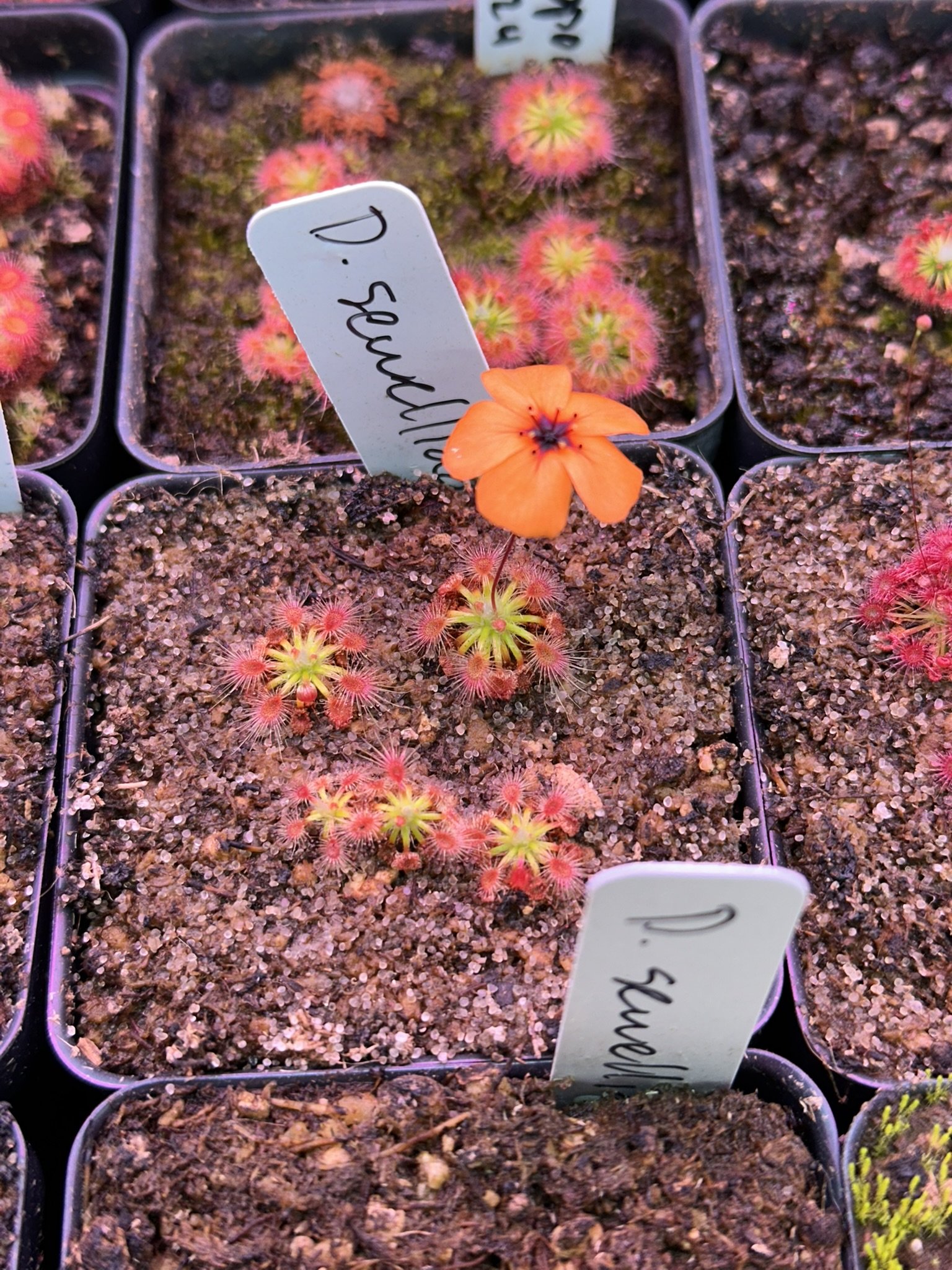 Image 1 of 7
Image 1 of 7

 Image 2 of 7
Image 2 of 7

 Image 3 of 7
Image 3 of 7

 Image 4 of 7
Image 4 of 7

 Image 5 of 7
Image 5 of 7

 Image 6 of 7
Image 6 of 7

 Image 7 of 7
Image 7 of 7








Drosera sewelliae
Description
Drosera sewelliae is a dainty pygmy with giant orange flowers with a black center. While the rosettes barely reach 1” in diameter, the flowers can exceed the size of the plant itself. The attractive metallic-orange flowers have wide petals with ball-shaped black stigmas and are some of the largest of all Pygmies. The leaves have bright green petioles with circular lamina producing long, red tentacles. Drosera sewelliae is a rare and distinct pygmy that is highly desired in any collection!
As a pygmy sundew, it will produce ‘gemmae’ which are tiny modified leaves that appear as geometric circles of buds in the center of the growing point each fall. Each gemma can detach from the main plant and rapidly grow into a new plant (much faster than planting seed).
Drosera sewelliae produces relatively large gemmae around 1.5mm in diameter and a flattened hemisphere shape. Adjust the photoperiod to be 9-10 hours in winter, gradually cycling to 14-15 hours in summer. They require proper lighting cues to produce gemmae and to flower in spring.
Plants are potted in 2.5”W x 2.5”D x 3.5”H plastic pots and each will contain at least 2 plants.
Growing Information
Climate: Mediterranean (SW Australia). 40-100F, low to moderate humidity.
Light: Full Sun or 20W per sq ft LED light. Pygmy sundews love bright light.
Water: Distilled or Reverse Osmosis water. Sitting in 0.5” of water using tray method.
Soil: 40% Peat: 60% Perlite/Sand is a good mix. Pygmy Sundews like well draining soils. Rinse media with distilled or reverse osmosis water to remove excess salts.
Feeding: Feed leaves with Fish Food Powder every few weeks or so. Pygmy Sundews love to eat and can be fed as long as there are dewy leaves.
More detailed growing information here: Pygmy Sundew Cultivation
Description
Drosera sewelliae is a dainty pygmy with giant orange flowers with a black center. While the rosettes barely reach 1” in diameter, the flowers can exceed the size of the plant itself. The attractive metallic-orange flowers have wide petals with ball-shaped black stigmas and are some of the largest of all Pygmies. The leaves have bright green petioles with circular lamina producing long, red tentacles. Drosera sewelliae is a rare and distinct pygmy that is highly desired in any collection!
As a pygmy sundew, it will produce ‘gemmae’ which are tiny modified leaves that appear as geometric circles of buds in the center of the growing point each fall. Each gemma can detach from the main plant and rapidly grow into a new plant (much faster than planting seed).
Drosera sewelliae produces relatively large gemmae around 1.5mm in diameter and a flattened hemisphere shape. Adjust the photoperiod to be 9-10 hours in winter, gradually cycling to 14-15 hours in summer. They require proper lighting cues to produce gemmae and to flower in spring.
Plants are potted in 2.5”W x 2.5”D x 3.5”H plastic pots and each will contain at least 2 plants.
Growing Information
Climate: Mediterranean (SW Australia). 40-100F, low to moderate humidity.
Light: Full Sun or 20W per sq ft LED light. Pygmy sundews love bright light.
Water: Distilled or Reverse Osmosis water. Sitting in 0.5” of water using tray method.
Soil: 40% Peat: 60% Perlite/Sand is a good mix. Pygmy Sundews like well draining soils. Rinse media with distilled or reverse osmosis water to remove excess salts.
Feeding: Feed leaves with Fish Food Powder every few weeks or so. Pygmy Sundews love to eat and can be fed as long as there are dewy leaves.
More detailed growing information here: Pygmy Sundew Cultivation